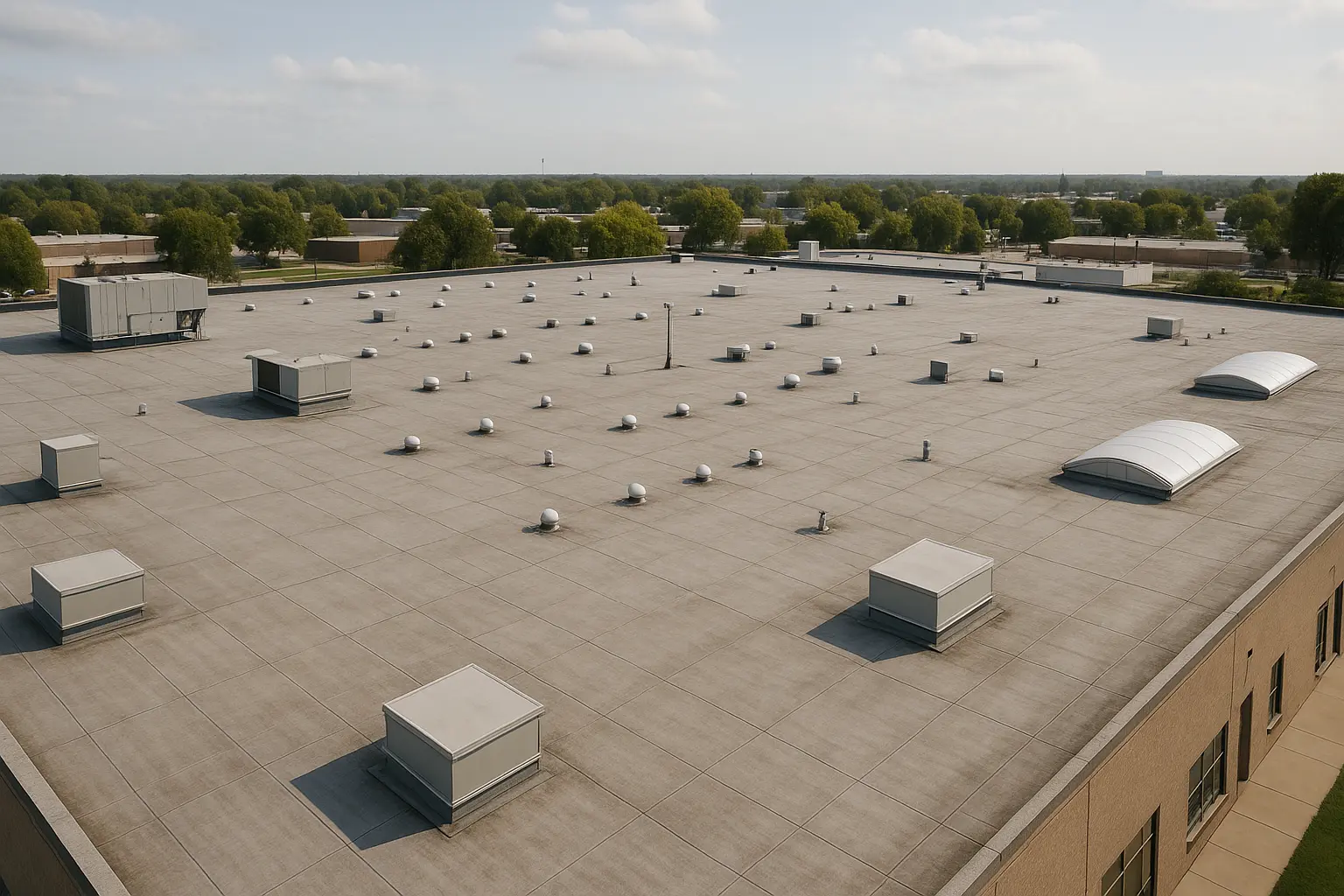If you own or manage a commercial building in Wichita or a nearby city like Derby or Newton, your roof goes through a lot each year. Hail, wind, rain, and snow can cause damage over time. While regular maintenance is important, there’s another step many building owners forget—keeping clear, accurate records.
Roof maintenance records help you stay prepared. They protect you from unexpected repair costs, make insurance claims easier, and show that you’ve taken proper care of your property.
This article explains which records matter most, why they’re important, and how Solid Rock Commercial Roofing can help you stay organized.
Key Takeaways
- Roof maintenance records are essential for protecting your investment, supporting insurance claims, and staying compliant with warranties and inspections.
- Well-kept documentation can save thousands by catching small issues early and proving your due diligence during storms, building sales, or legal challenges.
- Important records to keep include:
- Installation contracts and diagrams
- Warranty documents
- Inspection reports (at least twice yearly and after major storms)
- Repair and service logs
- Equipment or modification records
- Storm damage assessments
- Leak and moisture incident reports
- Installation contracts and diagrams
- Organize your records both digitally and physically. Use clear file names, folders, and reminders for inspections and warranty deadlines.
- Neglecting documentation can lead to:
- Denied insurance claims
- Canceled warranties
- Higher repair costs
- Potential legal problems from water damage or tenant complaints
- Denied insurance claims
- Solid Rock Commercial Roofing helps property owners not just with roof care, but with easy-to-read reports, warranty tracking, and organized documentation to support your property’s long-term performance.
- Act before problems occur. Schedule an inspection or maintenance plan with Solid Rock to stay prepared and protected.
Why Roofing Records Matter
Taking care of your roof means more than fixing problems when they happen. You also need a record of when inspections and repairs were done—and who did the work.
1. Save Money in the Long Run
Fixing a small problem costs a lot less than fixing major damage. Regular inspections can catch issues early. When you track repairs and inspections, you’re less likely to miss something that could turn into a costly problem.
Example: A torn seam is found during a spring inspection. It’s sealed right away. Without that fix, summer storms could have caused leaks and water damage inside the building.
2. Make Insurance Claims Easier
After a storm, insurance companies may ask for proof that your roof was in good shape beforehand. With detailed inspection reports and repair records, your claim is more likely to be approved without delays.
3. Be Ready for Inspections and Building Sales
If you plan to sell your building, refinance, or pass a city inspection, having roof maintenance records makes the process faster and smoother. Buyers, banks, and inspectors will want to see that the roof has been well cared for.
What to Keep in Your Roofing File
Let’s break down the main documents you should save:
A. Installation Records
These include:
- The contractor’s name and contact details
- Dates of when work started and finished
- Materials used
- Final cost and receipts
- Roof drawings or plans, if available
These documents explain what kind of roof you have and how it was built.
B. Warranty Information
Most roofs come with two warranties:
- A manufacturer’s warranty (for the roofing materials)
- A contractor’s warranty (for the labor and installation)
You should keep:
- Copies of both warranties
- Start and end dates
- Details about what is and isn’t covered
- Instructions for keeping the warranty valid (like scheduling regular inspections)
If you don’t follow the warranty rules, coverage can be canceled—even if your roof is still within the warranty period.
C. Regular Inspection Reports
Plan to have your roof inspected at least twice a year—in the spring and fall. After strong storms, schedule extra inspections.
Each report should include:
- The inspection date
- A summary of the roof’s condition
- Photos of any damage
- Recommended repairs or next steps
Example: A business in Wichita gets a fall inspection. The roofer finds leaves blocking a drain. Cleaning it out now prevents ice buildup during the winter.
D. Repair and Service Records
For each repair or service call, write down:
- What the problem was
- Who made the repair
- When it was done
- What materials or parts were used
- The cost and payment info
This helps future roofers understand what’s already been fixed and prevents repeated work.
E. Records for Add-Ons and Equipment
If new equipment is added—like HVAC units, skylights, or solar panels—save:
- Dates of installation
- Contractor information
- Any roof changes made during the installation
These updates can affect how water drains and may even change your warranty coverage.
F. Storm Damage Logs
After a hailstorm or high winds, take photos of your roof, even if there’s no clear damage. Write a short note about the weather and what you observed.
Later, if you find a leak or file a claim, these notes will show what the roof looked like after the storm.
G. Leak and Water Damage Reports
Any time there’s a leak:
- Note when you found it
- Take pictures
- Track your communication with contractors
- Record what was done to fix it
Keeping this information helps protect you if a tenant or nearby business claims the leak caused them damage.
How to Keep Your Records Organized
Staying organized doesn’t have to be hard. Here are three simple tips:
1. Use Digital Storage
Set up folders in Google Drive, Dropbox, or another cloud system. Label files with clear names like “Spring_2025_Roof_Inspection.pdf” or “Warranty_ABC_Materials.pdf.”
2. Keep a Paper Copy
Print your most important documents and store them in a labeled binder. Keep this binder in your office or another dry, secure place—away from basements, closets, or roof access points where water or pests might damage it.
3. Use Calendar Reminders
Set alerts on your phone or computer to remind you about:
- Spring and fall inspections
- Warranty expiration dates
- Seasonal maintenance tasks
What Happens If You Don’t Keep Records
If you forget to save this information, problems can pile up quickly.
1. Denied Insurance Claims
Without proof of roof care, your insurance company might say the damage was due to poor maintenance. That could mean paying thousands out of pocket.
2. Voided Warranties
Many warranties require regular inspections. If you can’t prove you followed the rules, the warranty may be canceled—even if your roof is still under coverage.
3. More Expensive Repairs
Without a clear history, a new contractor might have to guess what’s under your roof or repeat past repairs. That means more labor, more time, and higher bills.
4. Legal Problems
If a leak damages equipment or affects another tenant, you could be blamed. Good records show that you took action quickly and responsibly.
How Solid Rock Commercial Roofing Can Help
At Solid Rock, we help commercial building owners in Wichita and nearby towns stay on top of their roof care and documentation. When you work with us, you’ll get:
- Easy-to-read inspection reports with photos and repair suggestions
- Post-storm checkups with reports you can send directly to your insurance company
- Help with warranty tracking and filing
- Reminders for your regular maintenance schedule
Example: After a hailstorm, a Derby business called us for a quick inspection. We took photos, wrote a full report, and sent it the same day. The owner shared it with their insurance company and got approval for repairs within a week.
Conclusion
Your roof protects your building, your business, and the people inside. But it can’t do its job well if it’s ignored. And when it comes time to prove that you’ve taken care of your roof, having good records is just as important as the repairs themselves.
Don’t wait until a storm hits or a leak causes costly damage. Get ahead of the problem.
Solid Rock Commercial Roofing is here to help you stay organized and ready. From inspections to paperwork, we’re your partner in roof care.
Call today to schedule your inspection or start your maintenance plan.
Visit https://solidrockcorp.com/contact-us/ or call (316) 227-2628 to talk with our team.
Frequently Asked Questions (FAQs)
Why do I need to keep records for my commercial roof?
Keeping records helps prove that your roof has been properly maintained. This is important for warranty coverage, insurance claims, building inspections, and future resale of your property.
What types of documents should I save?
You should keep:
- Installation records
- Warranty paperwork
- Inspection reports
- Repair and service logs
- Equipment and add-on installation details
- Storm damage notes and photos
- Leak and moisture reports
How often should my roof be inspected?
At least twice a year—once in the spring and once in the fall. You should also have it inspected after any major storm or severe weather event.
What happens if I don’t have these records?
You may risk losing warranty protection, facing denied insurance claims, or paying more for future repairs. Lack of records can also lead to legal trouble if water damage affects tenants or neighboring businesses.
Can Solid Rock Commercial Roofing help me with documentation?
Yes. Solid Rock provides detailed inspection reports, storm assessments, warranty support, and even maintenance reminders to keep your roof and records in top shape.
Do photos matter when it comes to roof records?
Yes. Photos provide visual proof of your roof’s condition before and after weather events. They’re very helpful for insurance claims and repair planning.
Should I keep paper or digital records?
Both. Use digital storage (like Google Drive) for easy access and sharing, and keep printed copies of key documents in a safe, dry place as a backup.
How can I start organizing my records now?
Begin by gathering any contracts, warranties, inspection reports, or receipts you already have. Create folders (physical and digital) for each type of document. Solid Rock can also help you create a simple system moving forward.
This article is a collaboration between Solid Rock Corporation and OpenAI’s ChatGPT. Created on Aug 5, 2025, it combines AI-generated draft material with Solid Rock’s expert revision and oversight, ensuring accuracy and relevance while addressing any AI limitations.




